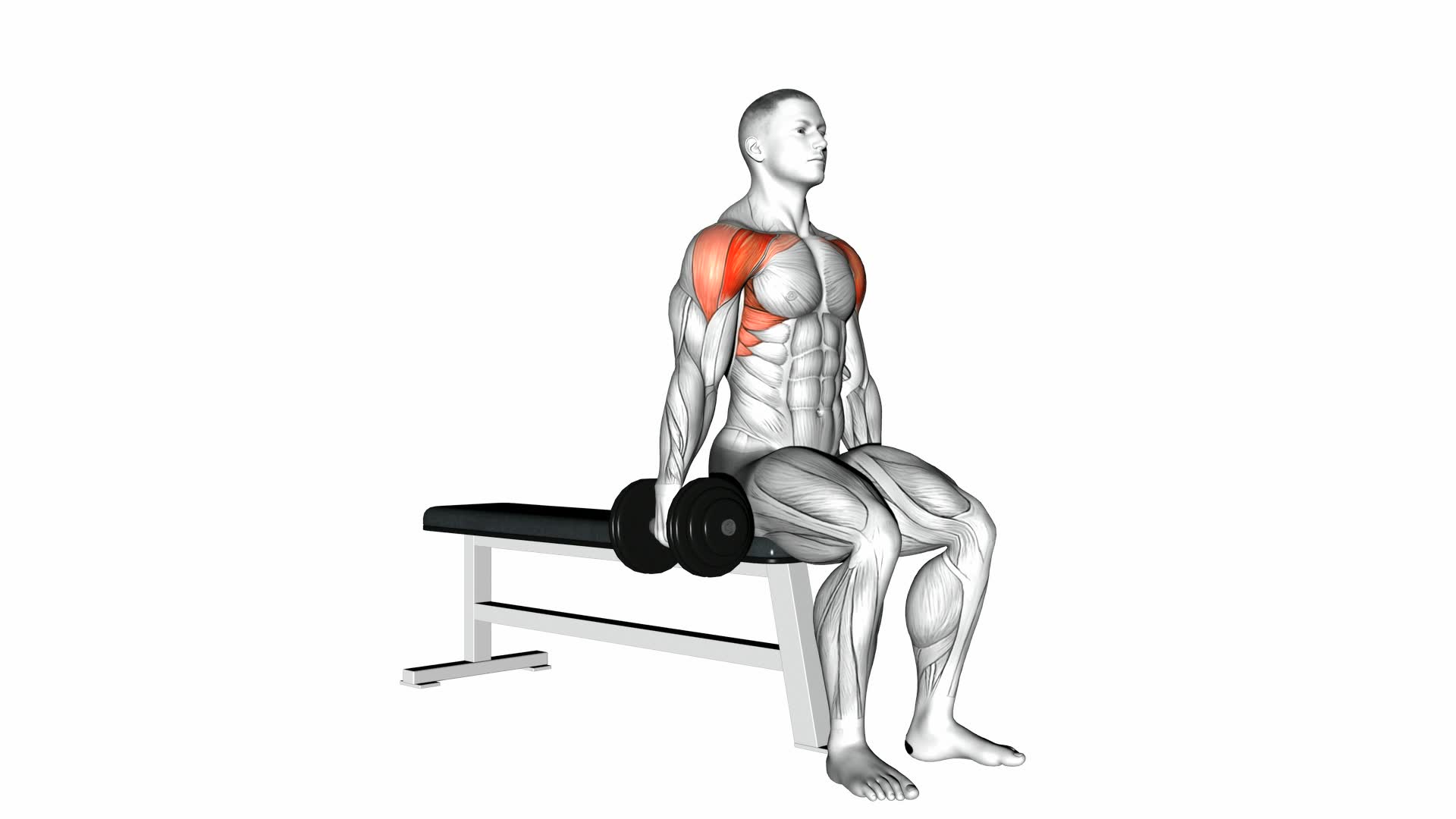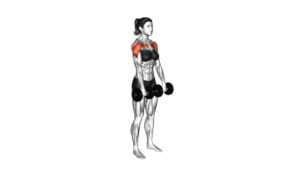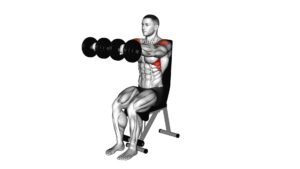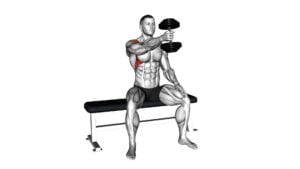Dumbbell Seated Alternate Front Raise – Video Exercise Guide & Tips

Are you looking to strengthen your shoulders and improve your upper body strength? Look no further than the dumbbell seated alternate front raise.
Watch This Exercise Video
This exercise is a great way to target your shoulder muscles and build definition. In this video exercise guide, you'll learn the proper form and technique, as well as tips for choosing the right weight and avoiding common mistakes.
Get ready to take your shoulder workout to the next level!
Key Takeaways
- Dumbbell seated alternate front raise targets shoulder muscles and builds definition
- Proper form and technique are important for shoulder alignment and elbow positioning
- Choosing the right weight and avoiding injury risks is crucial for a safe and effective workout
- Progression and avoiding common mistakes are essential for optimal results and muscle growth
Benefits of Dumbbell Seated Alternate Front Raise
You should regularly incorporate the dumbbell seated alternate front raise into your workout routine to maximize its benefits.
There are some common misconceptions about this exercise that need to be addressed. One of them is the belief that it only targets the front delts. While it does primarily work the front delts, it also engages the side delts and upper traps. This exercise is a great way to build overall shoulder strength and stability.
If you're looking for alternatives or variations, you can try the standing alternate front raise or the Arnold press. The standing alternate front raise allows for a greater range of motion and engages more stabilizer muscles. The Arnold press adds rotation to the movement, targeting different areas of the shoulder.
Proper form and technique are crucial when performing the dumbbell seated alternate front raise. Keep your back straight and core engaged throughout the movement. Start with a light weight and gradually increase as you become more comfortable and confident. Remember to exhale as you lift the dumbbells and inhale as you lower them.
In the next section, we'll discuss the proper form and technique in more detail to ensure you get the most out of this exercise.
Proper Form and Technique
To perform the dumbbell seated alternate front raise with proper form and technique, it's important to focus on shoulder alignment and elbow positioning. Make sure to keep your shoulders back and down, avoiding any hunching or rounding of the upper back.
Additionally, keep your elbows slightly bent and close to your body to provide stability and prevent strain on the joints. By maintaining these points, you can maximize the effectiveness of the exercise and reduce the risk of injury.
Shoulder Alignment During Exercise
Maintaining proper shoulder alignment is crucial for performing the Dumbbell Seated Alternate Front Raise exercise with correct form and technique. When it comes to shoulder mobility, it's important to ensure that your shoulders are relaxed and not hunched forward during the exercise. This will allow for a full range of motion and prevent any unnecessary strain on your joints.
Additionally, proper shoulder alignment promotes muscle activation in the targeted muscles, such as the anterior deltoids. To achieve this, imagine pulling your shoulder blades down and back, keeping your chest lifted throughout the movement. By maintaining proper shoulder alignment, you can maximize the effectiveness of the exercise and reduce the risk of injury.
Now, let's move on to the next section about elbow positioning for stability.
Elbow Positioning for Stability
Proper elbow positioning is essential for maintaining stability during the Dumbbell Seated Alternate Front Raise exercise. When performing this exercise, it's important to keep your elbows slightly bent and close to your body. This positioning helps to engage the muscles in your shoulders and prevents strain on your joints.
By keeping your elbows stable, you're able to effectively control the movement of the dumbbells and avoid any unnecessary swaying or swinging. This not only ensures proper form but also reduces the risk of injury.
Maintaining stability in your elbows allows you to focus on targeting your shoulder muscles, resulting in a more effective workout. Now that you understand the importance of elbow positioning for stability, let's move on to the next section about choosing the right weight.
Choosing the Right Weight
When choosing the right weight for your dumbbell seated alternate front raise, there are a few key points to consider.
First, selecting a weight that allows you to maintain proper form is crucial to avoid injury.
Secondly, it's important to find a weight that challenges you without compromising your technique.
Lastly, as you progress and get stronger, gradually increasing the weight will help you continue to challenge your muscles and see improvements in your performance.
Proper Weight Selection
To ensure optimal results and minimize the risk of injury, it's important for you to carefully consider and select the appropriate weight for your dumbbell seated alternate front raises.
Choosing the right weight is crucial in avoiding shoulder injuries and gradually increasing resistance over time. When starting out, it's recommended to begin with lighter weights to focus on proper form and technique.
As you become more comfortable and stronger, you can gradually increase the weight to challenge your muscles. It's important to find a weight that allows you to complete the exercise with proper form and without straining or excessively swinging the dumbbells.
Avoiding Injury Risk
Carefully consider and select the appropriate weight for your dumbbell seated alternate front raises to minimize the risk of injury and ensure optimal results. Here are some key tips to help you choose the right weight and prevent injuries:
- Start with a lighter weight: Begin with a weight that feels comfortable and allows you to perform the exercise with proper form.
- Gradually increase the weight: As you become stronger and more comfortable with the exercise, gradually increase the weight to continue challenging your muscles.
- Avoid excessive weight: It's important not to choose a weight that's too heavy, as this can lead to poor form and increase the risk of injury.
- Warm up exercises: Prior to performing the dumbbell seated alternate front raises, warm up your muscles with dynamic stretches or light cardio exercises to increase blood flow and flexibility.
Progression and Challenge
To ensure optimal results and minimize the risk of injury, it's important that you carefully select the appropriate weight for your dumbbell seated alternate front raises. Progression techniques and advanced variations can help you challenge yourself and continue to make progress in your strength training journey.
When choosing the right weight for your dumbbell seated alternate front raises, start with a weight that allows you to perform the exercise with proper form and without straining your muscles. As you become more comfortable with the exercise, gradually increase the weight to continue challenging your muscles.
To further progress and challenge yourself, you can try advanced variations of the dumbbell seated alternate front raise. This could include increasing the weight, performing more reps or sets, or incorporating other exercises into your routine.
Common Mistakes to Avoid
Avoid swinging your arms or using momentum to lift the dumbbells during the Dumbbell Seated Alternate Front Raise exercise. This is a common mistake that can compromise the effectiveness of the exercise and increase the risk of injury. To ensure you're performing the exercise correctly, here are some key points to keep in mind:
- Maintain proper posture: Sit upright with your back straight and shoulders relaxed. Avoid slouching or leaning forward, as this can strain your neck and back.
- Engage your core: Activate your abdominal muscles to stabilize your body throughout the exercise. This will help prevent excessive movement and maintain control.
- Control the movement: Lift the dumbbells in a slow and controlled manner, focusing on using your shoulder muscles to perform the movement. Avoid jerking or using momentum to lift the weights.
- Use an appropriate weight: Choose a weight that challenges your muscles without compromising your form. If you find yourself swinging or using momentum, it may be a sign that the weight is too heavy.
Variations and Modifications
To incorporate variations and modifications into the Dumbbell Seated Alternate Front Raise exercise, try adjusting the grip on the dumbbells. By changing your grip, you can target different muscles and add variety to your workout routine.
One variation you can try is the hammer grip, where your palms face each other throughout the movement. This grip puts more emphasis on your forearms and biceps.
Another option is the pronated grip, with your palms facing down. This grip engages your shoulder muscles more intensely.
You can also experiment with different weights to challenge yourself and work different muscle groups. For instance, using lighter dumbbells can help improve endurance, while heavier dumbbells can focus on strength and muscle growth.
Additionally, you can modify the front raise exercise by performing it standing up instead of seated. This simple change engages your core and stabilizer muscles, making the exercise more challenging.
Remember to always maintain proper form and consult a professional if you have any concerns or questions about incorporating these dumbbell variations or modified front raises into your workout routine.
Tips for Maximized Results
For maximum results, focus on maintaining proper form and incorporating progressive overload into your dumbbell seated alternate front raise routine. Follow these tips to maximize gains and improve workout efficiency:
- Start with lighter weights: Begin with a weight that allows you to perform the exercise with proper form. As you become more comfortable and stronger, gradually increase the weight.
- Engage your core: Keep your abs engaged throughout the movement to maintain stability and prevent strain on your lower back.
- Control the movement: Avoid using momentum to lift the dumbbells. Instead, focus on controlled and deliberate motions to fully engage the targeted muscles.
- Increase the intensity: To maximize gains, progressively overload your muscles by increasing the weight or reps over time. This challenges your muscles and stimulates growth.
Frequently Asked Questions
How Many Sets and Reps Should I Do for the Dumbbell Seated Alternate Front Raise?
To determine the sets and reps for the dumbbell seated alternate front raise, consider your fitness level and goals. Start with 2-3 sets of 8-12 reps, focusing on proper form and controlled movement.
If you have limited shoulder mobility, you can modify the exercise by using lighter weights or performing the exercise standing instead.
Remember to consult with a fitness professional for personalized guidance.
Can I Do This Exercise if I Have Shoulder Pain or a Previous Shoulder Injury?
If you have shoulder pain or a previous shoulder injury, it's important to prioritize shoulder pain management and shoulder injury prevention.
Before attempting any exercise, including the dumbbell seated alternate front raise, consult with a healthcare professional or a qualified trainer.
They can provide guidance on modifications or alternative exercises that will allow you to work on your shoulders without exacerbating any pain or risk of injury.
Safety should always be the top priority.
Should I Perform This Exercise at the Beginning or End of My Workout?
To determine whether to perform the dumbbell seated alternate front raise at the beginning or end of your workout, consider your goals.
If you aim to target your shoulder muscles and improve overall shoulder strength, it's recommended to perform this exercise at the beginning of your workout when you're fresh. This way, you can focus on proper form and technique, maximizing the benefits and effectively engaging the targeted muscle groups.
How Often Should I Incorporate the Dumbbell Seated Alternate Front Raise Into My Workout Routine?
To maximize the benefits of incorporating the dumbbell seated alternate front raise into your workout routine, you should perform it at least twice a week.
This exercise targets your shoulders and helps to strengthen and tone the muscles in that area.
By regularly incorporating this exercise, you can improve your overall shoulder strength and stability.
Remember to start with lighter weights and gradually increase the resistance as you become more comfortable with the movement.
Are There Any Alternatives or Modifications for Individuals With Limited Shoulder Mobility?
If you have limited shoulder mobility, there are alternatives and modifications you can consider.
Instead of the dumbbell seated alternate front raise, you can try exercises like the standing cable front raise or the resistance band front raise.
These exercises can still target your front delts effectively while accommodating your shoulder limitations.
Remember to start with light weights or resistance and focus on maintaining proper form throughout the movements.
Conclusion
To conclude, the dumbbell seated alternate front raise is an effective exercise for targeting the front deltoids.
By maintaining proper form and choosing the appropriate weight, you can maximize the benefits of this exercise.
Avoid common mistakes and consider variations or modifications to challenge yourself further.
Remember to follow these tips to achieve the best results and optimize your workout routine.

Author
Years ago, the spark of my life’s passion ignited in my mind the moment I stepped into the local gym for the first time. The inaugural bead of perspiration, the initial endeavor, the very first surge of endorphins, and a sense of pride that washed over me post-workout marked the beginning of my deep-seated interest in strength sports, fitness, and sports nutrition. This very curiosity blossomed rapidly into a profound fascination, propelling me to earn a Master’s degree in Physical Education from the Academy of Physical Education in Krakow, followed by a Sports Manager diploma from the Jagiellonian University. My journey of growth led me to gain more specialized qualifications, such as being a certified personal trainer with a focus on sports dietetics, a lifeguard, and an instructor for wellness and corrective gymnastics. Theoretical knowledge paired seamlessly with practical experience, reinforcing my belief that the transformation of individuals under my guidance was also a reflection of my personal growth. This belief holds true even today. Each day, I strive to push the boundaries and explore new realms. These realms gently elevate me to greater heights. The unique combination of passion for my field and the continuous quest for growth fuels my drive to break new ground.







